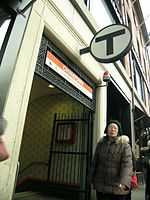Chinatown (MBTA station)
CHINATOWN
CHINATOWN | ||||||||||||||||||||
|---|---|---|---|---|---|---|---|---|---|---|---|---|---|---|---|---|---|---|---|---|
 Inbound platform | ||||||||||||||||||||
| Station statistics | ||||||||||||||||||||
| Address |
640 Washington Street and 1 Boylston Street Boston, MA | |||||||||||||||||||
| Coordinates | 42°21′08″N 71°03′46″W / 42.3522°N 71.0627°WCoordinates: 42°21′08″N 71°03′46″W / 42.3522°N 71.0627°W | |||||||||||||||||||
| Line(s) | ||||||||||||||||||||
| Platforms | 2 side platforms | |||||||||||||||||||
| Tracks | 2 | |||||||||||||||||||
| Other information | ||||||||||||||||||||
| Opened |
November 30, 1908 (Orange Line) July 20, 2002 (Silver Line) | |||||||||||||||||||
| Accessible |
| |||||||||||||||||||
| Owned by | Massachusetts Bay Transportation Authority | |||||||||||||||||||
| Formerly |
Boylston Street / Essex (1908 - 1967) Essex (1967 - 1987)[1] | |||||||||||||||||||
| Traffic | ||||||||||||||||||||
| Passengers (2009 daily) | 5,822[2] | |||||||||||||||||||
| Services | ||||||||||||||||||||
| ||||||||||||||||||||
| Location | ||||||||||||||||||||
 | ||||||||||||||||||||
Chinatown is an MBTA subway station on the Orange Line, located at the intersection of Washington Street with Essex Street and Boylston Street, roughly at the northwestern corner of Boston, Massachusetts' Chinatown neighborhood. Like all Orange Line stations, both the subway platforms and all bus connections are fully wheelchair accessible.[3]
The two platforms are offset horizontally and vertically, and are not connected, so there is no free transfer between inbound and outbound trains. The station entrances are integrated into buildings on either side of Washington Street. The inbound platform has an exit, now blocked off and for emergencies only, that leads to a pair of small "orphaned" headhouses on Hayward Place.
History
The station originally opened on November 30, 1908 along with the rest of the Washington Street Tunnel. At this time, the Boston Electric Railway's Main Line (which later became the Orange Line) was moved from the Tremont Street Subway into this new subway. As in other stations of the Washington Street Tunnel, the platforms were largely separated and given different names - Boylston for the southbound platform, and Essex for the northbound side.[4]
On February 11, 1967, as part of a larger renaming of Orange Line stations, the entire station became Essex. On May 4, 1987, the station was renamed Chinatown concurrent with the opening of the Southwest Corridor.[1] There are additional entrance/exit stairs and passages leading to Lagrange Street and Hayward Place that were closed off in 1972, though they are still used as emergency exits. A long sub-passage connecting the inbound and outbound platforms exists, but was sealed off before the station was opened in 1908.[5] Silver Line service on Washington Street between Dudley and Downtown Crossing started on July 20, 2002. Additional service to South Station began on October 15, 2009.
Nearby attractions
In addition to its location at the edge of Boston's Chinatown, the station is located within the Washington Street Theatre District. Just one block away is Emerson College, which has special programs in the theater arts.
Bus connections
Chinatown serves both routes of the Washington Street section of the Silver Line, which operates between downtown and Dudley. The SL4 route serves South Station, while the SL5 route serves Downtown Crossing and Boylston. The station also sees conventional bus service from the 11 City Point - Downtown BayView Route.
Station layout
| G | Street Level | Exit/Entrance |
| Inbound | → Silver Line toward South Station (SL4) (Terminus) → → Silver Line toward Downtown Crossing (SL5) (Terminus) → | |
| M | Mezzanine | To entrances/exits |
| P Platform level |
Side platform, doors will open on the right | |
| Southbound | ← Orange Line toward Forest Hills (Tufts Medical Center) | |
| Northbound | → Orange Line toward Oak Grove (Downtown Crossing) → | |
| Side platform, doors will open on the right | ||
Images
-

Station entrance on inbound side of Washington Street
-

Outbound platform
-
Decorative metalwork on inbound entrance
-
Emergency exit from inbound platform
-
Emergency exit headhouses on Hayward Place were built into now-demolished buildings
-

Two now defunct IN/OUT doors on the South side of Essex Street just east of Washington Street, once connected with the now Chinatown Orange Line station (January 2013)
References
- ↑ 1.0 1.1 Belcher, Jonathan (31 December 2011). "Changes to Transit Service in the MBTA district" (PDF). NETransit. Retrieved 28 January 2012.
- ↑ "Ridership and Service Statistics". Massachusetts Bay Transportation Authority. 2010.
- ↑ Tran Systems and Planners Collaborative (24 August 2007). "Evaluation of MBTA Paratransit and Accessible Fixed Route Transit Services: Final Report". Massachusetts Bay Transportation Authority. Retrieved 8 June 2012.
- ↑ "Forgotten Boston: The MBTA's Hidden Entrances", forgotten-boston.com
- ↑ Annual report of the Boston Transit Commission, Volume 11. plate 8: Boston Transit Commission. 1905. pp. 50–53.
External links
![]() Media related to Chinatown (MBTA station) at Wikimedia Commons
Media related to Chinatown (MBTA station) at Wikimedia Commons


